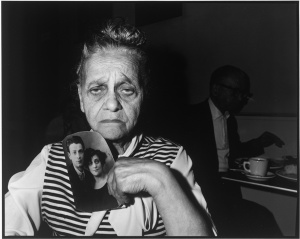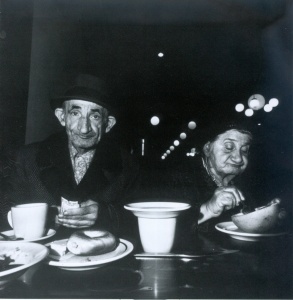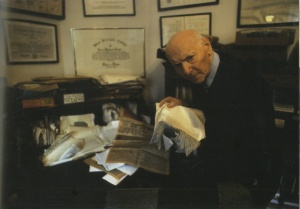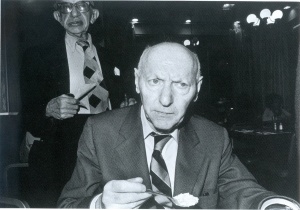Davidson, Singer and the Jews
Sometime in 1967 Bruce Davidson, the photographer, met Isaac Bashevis Singer, the writer, and they went down to the Lower East Side to the Garden Cafeteria to chat, have coffee and rice pudding. It began a creative friendship that lasted more than twenty years until Singer passed away in 1991.
They were from radically different backgrounds, over 30 years apart in age, one an assimilated Midwestern American Jew and the other a Yiddish speaking Polish Jew. And yet they formed a remarkable bond that one can glimpse in the exhibition Isaac Bashevis Singer and the Lower East Side: Photographs by Bruce Davidson currently at the Jewish Museum.
These two artists shared a common methodology; they liked to watch. Their respective intense observations of the human condition, up close and amazingly personal, is what binds their otherwise disparate creative works. Bruce Davidson, born in 1933, is a celebrated photographer whose work is best known by his extensive photo essays, patiently exploring a single subject in depth. Starting in the 1950s his photo essays have included the Widow of Montmarte (Paris), Brooklyn Gang (1959), The Dwarf (1963), Subway (1986), Civil Rights Movement (1961-1965) and East 100th Street (1970), the last two exhibited at the Museum of Modern Art and considered classics of socially conscious and personally penetrating photo journalism. When taking on an assignment Davidson practically moves in with his subjects, spending weeks, months and even years living, eating and sleeping in the same environment to earn their trust and confidence. The result of this concentration in time and effort, is the portrayal of the very fabric of their lives that animates his photographs.
In a rather startling way the same mechanism is operating in the literary work of Isaac Bashevis Singer, except from the exact opposite direction. For Singer it is the gritty and complex reality of his own life and his observations of those around him that provides the raw material for his novels, essays and short stories. Singer was born in 1902 in Leoncin, Poland near Warsaw. He grew up in a pious family; his father was a Hasidic rabbi and Rosh Yeshiva at the court of the Rabbi of Radzymin, and naturally had a yeshiva education. They moved from Warsaw to a shtetl and finally in 1935 fled the rise of fascism to New York where he started writing for the Forward which he contributed to for most of his life. In the 1940s he finally settled in the Upper West Side but soon made the Garden Cafeteria at the corner of East Broadway and Rutgers Street his second home. The kosher dairy cafeteria (in the early years open 24 hours a day) was half a block from his newspaper, the Forverts (The Jewish Daily Forward). Known as “Yiddish newspaper Row” the street was also home to the Orthodox Yiddisher Tageblatt (Yiddish Daily Paper), Wahrheit (Truth), Der Tog (The Day), Morgen Zhurnal (Morning Journal) and even a humorous weekly Der Groyser Kundes (The Big Stick). The cafeteria was a familiar hangout to a panoply of neighborhood Jews from every walk of life; garment shop owners, immigrant workers, union organizers, the old and infirm, local Yiddish actors, all brands of radicals and politicos, and of course the staff of the Yiddish papers just steps away. It was also a Garden of Paradise of the Yiddish language. As the Jewish Lower East Side continued its slow decline and the repercussions of the Holocaust crippled Yiddish culture, Singer continued to believe that the language and literature still had a future. The Yiddish speaking world of the Garden Cafeteria confirmed this hope and simultaneously challenged it.

The exhibition is neatly divided into three sections of photographs and one video. We are first introduced to Davidson’s work on the Lower East Side with two photos from 1957 and then the Garden Cafeteria portfolio from 1973 and one 1975 image. Perhaps the image of Mrs. Bessie Gakaubowicz best sums up the feeling of a kind of defiant desperation. Holding a photograph of her and her husband taken before the War she recounts her life as filled with fear and now, loneliness: “…in Russia, the Cossacks, in Poland, the government, in Paris, Hitler and here, I am afraid too.” She is the epitome of the Jew caught in a Diaspora that seems to have no mercy. She is the living remnant of a Yiddish world caught on a dead end street. She is Isaac Bashevis Singer’s nightmare.

These images are Davidson’s masterpieces, somehow documenting an entire neighborhood that could be found in Singer’s mind, the pain and anxiety of being a constant immigrant, a “human remnant” in Singer’s own words. Storekeepers from a candy store on Avenue B is yet another penetrating insight into a social reality. The lights of the cafeteria recede behind them creating a kind of visual map of their past, years of struggle, work and striving. And now they sit eating a simple repast; bagel, coffee and a grapefruit. He holds a ticket that allows him and his spouse to occupy the present, to stay as long as they dare. Most poignantly the future is encapsulated in the covered cup of coffee that visually unites them in the foreground. The futile attempt to keep it hot and palatable is what fortifies them to go on.
The next ten photographs are mostly portraits of Lower East Siders. Local merchants, Rabbi A. M. Eisenbach, the brothers Rabbi Moishe and Rabbi Joseph Singer, and Gus’s Pickles vie with photos of other locals that Davidson took when he returned in 1990 to revisit and re-inhabit the Lower East Side. They are beautiful and powerful because we inherently recognize the actors but are vastly different from the earlier series. Gone is overwhelming existential anxiety experienced by the haunted strangers who make the cafeteria their home.

Finally Davidson turns his unrelentingly personal gaze on the author himself, inhabiting his home turf, his apartment on the Upper West Side and the streets of upper Broadway. Singer scowls at us from inside his apartment, stops to chat with a homeless woman on 79th Street and quizzically gazes up from his park bench in the middle of upper Broadway. Davidson’s photos, even including a shot of Singer sitting up in bed with a breakfast tray, continues his modus operandi of invading the most private corners of his subject’s life. Isaac Bashevis Singer in his study (1978) crowns these images with a color portrait of Singer looking up from a manuscript, hovering over his paper strewn desk. It is overflowing with papers, Yiddish newspaper clippings, letters, unfinished drafts and God-knows what else of literary merit. The chaos of the artistic process is shockingly exposed for all to see so that we now understand that putting words together to make a story or a novel is no simple task. Rather it takes tremendous concentration and energy to harness the cosmos of a life’s experience to create a work of art.

Isaac Bashevis Singer’s literary output was impressive with 18 novels, 14 children’s books, memoirs, essays and at least five collections of short stories to his credit, all written in Yiddish and most originally written for newspapers. Much is still untranslated and that which has been were tightly edited by him. He was awarded the Nobel Prize for Literature in 1978. The subjects ranged from the complex world of Eastern European Jews to the troubled lives of survivors and immigrants he observed in New York. Notable is the famous “Yentl the Yeshiva Boy” (1962), a tragedy of a rebellious girl who with an uncontrollable love of Talmud dresses as a man to learn in Yeshiva, as well as “Enemies, A Love Story” (1972) in which a Holocaust survivor grapples with his loss of faith, desperation, subsequent intermarriage and affairs in post-war Manhattan. Many of his literary subjects could be found in spirit around the busy tables of the Yiddish speaking Garden Cafeteria.
And thus we can understand the hidden meaning of Davidson’s portrait of Singer actually taken in the Cafeteria itself, Isaac Bashevis Singer eating rice pudding (1975). We observe the author observing, listening carefully to every word spoken by an unseen cafeteria patron just across the table. Which is more substance to the writer, the rice pudding poised to be eaten or the words which may become a subject for his next story? We will never know except that Singer himself deeply appreciated the insight Davidson had achieved. Singer summed it up when he wrote in an introduction to the Garden Cafeteria portfolio:
“…Of course I observed the types and characters who visited the cafeteria. Although they were all poor and wore shabby clothes, they were rich in individuality. Every one of them complained about the misery of life in New York in his own style. They were unique in every possible way. I often thought how could one describe all this in a way which would both inform and entertain? Mr. Bruce Davidson has done it not with a pen, but with his camera. I consider myself lucky that he took also a picture of me among all these human remnants.”
I am indebted to Wikipedia.org and the catalogue essays of Jill Meredith, Ilan Stavans and Gabriele Werffeli for background historical and biographical information.
Isaac Bashevis Singer and the Lower East Side: Photographs by Bruce Davidson
Jewish Museum
1109 Fifth Avenue, New York, N.Y.